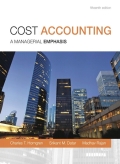
Cost Accounting
15th Edition
ISBN: 9780133428834
Author: Horngren
Publisher: PEARSON
expand_more
expand_more
format_list_bulleted
Concept explainers
Textbook Question
Chapter 17, Problem 17.13Q
Why should the accountant distinguish between transferred-in costs and additional direct materials costs for each subsequent department in a process-costing system?
Expert Solution & Answer
Want to see the full answer?
Check out a sample textbook solution
Students have asked these similar questions
Given correct answer general Accounting
Hi expert please help me
hi expert please help me
Chapter 17 Solutions
Cost Accounting
Ch. 17 - Give three examples of industries that use...Ch. 17 - In process costing, why are costs often divided...Ch. 17 - Explain equivalent units. Why are equivalent-unit...Ch. 17 - What problems might arise in estimating the degree...Ch. 17 - Name the five steps in process costing when...Ch. 17 - Name the three inventory methods commonly...Ch. 17 - Describe the distinctive characteristic of...Ch. 17 - Describe the distinctive characteristic of FIFO...Ch. 17 - Prob. 17.9QCh. 17 - Identify a major advantage of the FIFO method for...
Ch. 17 - Identify the main difference between journal...Ch. 17 - The standard-costing method is particularly...Ch. 17 - Why should the accountant distinguish between...Ch. 17 - Transferred-in costs are those costs incurred in...Ch. 17 - Theres no reason for me to get excited about the...Ch. 17 - Prob. 17.16ECh. 17 - Prob. 17.17ECh. 17 - Prob. 17.18ECh. 17 - Prob. 17.19ECh. 17 - Prob. 17.20ECh. 17 - Prob. 17.21ECh. 17 - Prob. 17.22ECh. 17 - Prob. 17.23ECh. 17 - Prob. 17.24ECh. 17 - Prob. 17.25ECh. 17 - Prob. 17.26ECh. 17 - Prob. 17.27ECh. 17 - Prob. 17.28ECh. 17 - Prob. 17.29ECh. 17 - Prob. 17.30PCh. 17 - Prob. 17.31PCh. 17 - Prob. 17.32PCh. 17 - Prob. 17.33PCh. 17 - Prob. 17.34PCh. 17 - Prob. 17.35PCh. 17 - Prob. 17.36PCh. 17 - Prob. 17.37PCh. 17 - Prob. 17.38PCh. 17 - Prob. 17.39PCh. 17 - Prob. 17.40PCh. 17 - Prob. 17.41PCh. 17 - Benchmarking, ethics. Amanda McNall is the...Ch. 17 - Prob. 17.43P
Knowledge Booster
Learn more about
Need a deep-dive on the concept behind this application? Look no further. Learn more about this topic, accounting and related others by exploring similar questions and additional content below.Similar questions
- Sub. General accountingarrow_forwardThe Esquire Clothing Company borrowed a sum of cash on October 1, 2024, and signed a note payable. The annual interest rate was 12%. The company's December 31, 2024, income statement reported interest expense of $1,260 related to this note. What was the amount borrowed?arrow_forwardThe Wazoo Company reported an $11,200 liability in its 2023 balance sheet for subscription revenue received in advance. During 2024, $62,000 was received from customers for subscriptions and the 2024 income statement reported subscription revenue of $63,700. What is the liability amount for deferred subscription revenue that will appear in the 2024 balance sheet?arrow_forward
arrow_back_ios
SEE MORE QUESTIONS
arrow_forward_ios
Recommended textbooks for you
- Principles of Accounting Volume 2AccountingISBN:9781947172609Author:OpenStaxPublisher:OpenStax College
 Managerial AccountingAccountingISBN:9781337912020Author:Carl Warren, Ph.d. Cma William B. TaylerPublisher:South-Western College Pub
Managerial AccountingAccountingISBN:9781337912020Author:Carl Warren, Ph.d. Cma William B. TaylerPublisher:South-Western College Pub Principles of Cost AccountingAccountingISBN:9781305087408Author:Edward J. Vanderbeck, Maria R. MitchellPublisher:Cengage Learning
Principles of Cost AccountingAccountingISBN:9781305087408Author:Edward J. Vanderbeck, Maria R. MitchellPublisher:Cengage Learning  College Accounting, Chapters 1-27AccountingISBN:9781337794756Author:HEINTZ, James A.Publisher:Cengage Learning,
College Accounting, Chapters 1-27AccountingISBN:9781337794756Author:HEINTZ, James A.Publisher:Cengage Learning, Cornerstones of Cost Management (Cornerstones Ser...AccountingISBN:9781305970663Author:Don R. Hansen, Maryanne M. MowenPublisher:Cengage Learning
Cornerstones of Cost Management (Cornerstones Ser...AccountingISBN:9781305970663Author:Don R. Hansen, Maryanne M. MowenPublisher:Cengage Learning Managerial Accounting: The Cornerstone of Busines...AccountingISBN:9781337115773Author:Maryanne M. Mowen, Don R. Hansen, Dan L. HeitgerPublisher:Cengage Learning
Managerial Accounting: The Cornerstone of Busines...AccountingISBN:9781337115773Author:Maryanne M. Mowen, Don R. Hansen, Dan L. HeitgerPublisher:Cengage Learning

Principles of Accounting Volume 2
Accounting
ISBN:9781947172609
Author:OpenStax
Publisher:OpenStax College

Managerial Accounting
Accounting
ISBN:9781337912020
Author:Carl Warren, Ph.d. Cma William B. Tayler
Publisher:South-Western College Pub

Principles of Cost Accounting
Accounting
ISBN:9781305087408
Author:Edward J. Vanderbeck, Maria R. Mitchell
Publisher:Cengage Learning

College Accounting, Chapters 1-27
Accounting
ISBN:9781337794756
Author:HEINTZ, James A.
Publisher:Cengage Learning,

Cornerstones of Cost Management (Cornerstones Ser...
Accounting
ISBN:9781305970663
Author:Don R. Hansen, Maryanne M. Mowen
Publisher:Cengage Learning

Managerial Accounting: The Cornerstone of Busines...
Accounting
ISBN:9781337115773
Author:Maryanne M. Mowen, Don R. Hansen, Dan L. Heitger
Publisher:Cengage Learning
Cost Classifications - Managerial Accounting- Fixed Costs Variable Costs Direct & Indirect Costs; Author: Accounting Instruction, Help, & How To;https://www.youtube.com/watch?v=QQd1_gEF1yM;License: Standard Youtube License